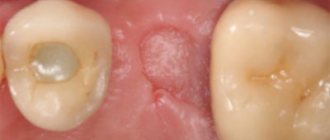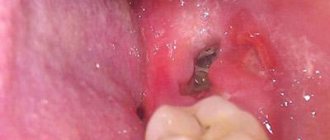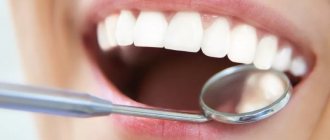Reasons for appearance
In medicine, a hole in the gum is called a fistula. A fistula appears as a consequence of the activity of harmful microorganisms that are located in the area of the alveolar process. As a rule, the causative agents of pathology are coccus bacteria.
That is, the main reason for the formation of a fistula is a large amount of pathogenic microflora in the mouth. Lack of hygiene, the accumulation of soft plaque and the formation of tartar provoke the appearance of a fistula in the gums. Over time, tartar grows and begins to put pressure on the gums. In addition, soft dental deposits spoil the aesthetics of a smile; pigment spots may appear on the enamel.
Another reason for the appearance of a fistula near a tooth may be infectious inflammation. Diseases such as tonsillitis, ARVI, and whooping cough reduce immunity, creating all the conditions for the proliferation of bacteria.
Fistula in the soft periodontal tissues after tooth extraction
The formation of a hole after tooth extraction is normal. As a rule, the hole heals within one to two weeks. If the operation was performed on wisdom teeth, the tightening process may take several weeks. Impaired socket tightening can occur due to infection or in case of injury to the area where the tooth was removed.
In a situation where the hole has tightened and a gap has formed in the periodontium, it may indicate that the tooth was not completely removed. Small fragments of the tooth gradually begin to decompose, forming a fistula.
Attachment of a secondary infection
The oral cavity is the most microorganism-rich place in the human body. Many pathogenic microbes can penetrate with food. The hole in the hole creates a kind of reservoir of food waste, leading to the accumulation of pathogenic microflora and the development of secondary infection (inflammatory process and suppuration). This interferes with the rapid healing of the holes. Alveolitis begins to develop against the background of infection when it gets into the wound.
Of course, it is unlikely that suppuration will occur after tooth extraction if you provide proper care and oral hygiene, wash your hands before eating, and do not put foreign objects into your mouth in order to pick out stagnant blood clots. In the first 2–3 days after tooth extraction, you should not:
- chew on the sore side;
- thoroughly brush your teeth, rinse your mouth to wash away blood clots;
- Use old toothbrushes that have a lot of bacteria on the bristles.
It is the infected tissue that is difficult to restore, so the healing process is slowed down. The time frame can drag on for many months, until the hole after tooth extraction heals on its own, leading to tissue granulation and the formation of normal young bone.
A fresh wound in the mouth is overly sensitive to various microorganisms and therefore does not heal for a long time. That is why it is so important to follow hygiene and all the doctor’s recommendations after tooth extraction, so that the hole heals faster and the regeneration process is accelerated.
The addition of a secondary infection leads to inflammation and suppuration of the socket and the development of alveolitis. It happens that when brushing your teeth, blood clots literally pop out under the pressure of water and nothing prevents bacteria from penetrating into the wounds again. After an extracted tooth, patients begin to complain of the following conditions:
- excessive bleeding;
- an increase in temperature to +38…+39ºС, as a characteristic sign of the development of inflammation;
- soreness;
- enlarged lymph nodes under the jaw;
- the appearance of flux.
It is normal for bleeding to stop 1 day after surgery. If signs of alveolitis appear, you should contact your dentist again as soon as possible.
Fistula between tooth and gum
A hole between a tooth and periodontal tissue indicates the development of cervical caries or the complications it caused. Cervical caries can be located between the teeth and not be visible to the naked eye. Due to its inaccessible location, such caries often turns into pulpitis.
Pulpitis is an inflammation of the blood vessels and nerve endings located in the pulp chamber of the tooth. The chronic stage of the pathology may be accompanied by the formation of a purulent focus in the soft tissues. If pulpitis progresses to the next stage of periodontitis, several fistulas may appear at once.
The main stages of socket healing after wisdom tooth removal
Conventionally, the regeneration reactions after extraction of the “eight” can be divided into stages. Many of them remain invisible to humans, as they relate to changes occurring in the deep tissues of the gums.
- Stop bleeding. Normally, blood stops flowing within two (maximum four) hours after extraction. On the first day, the patient may still detect a small amount of bloody impurities in the saliva. There's nothing wrong with that.
- Formation of a clot. Occurs on the first day after surgery. Usually at the time of its appearance there is an increase in pain in the wound area and increased swelling. Body temperature may rise slightly. Headaches are also possible. These negative symptoms disappear in one to two days. They usually do not require additional treatment.
- Formation of a thin epithelial layer on top of a blood clot. This stage occurs on the second to fourth days after dental surgery. Then the person sees that the hole has turned white or gray. The state of health at this point usually becomes satisfactory. Toothache no longer bothers me.
- On the fifth to eighth day, the area of gray connective tissue increases rapidly . The clot is visible only in its center. The swelling goes away. If stitches were placed after removal, now is the time to remove them.
- The surface of the wound is covered with granulation tissue. This occurs two to three weeks after removal. As a result, the gums begin to look normal.
- In the period from the third or fourth week to six months, bone tissue grows in the socket.
If the removal was carried out against the background of progressive periodontal disease or periodontitis, then the patient’s recovery period increases by about ten days.
Thus, a month after extraction, a person can chew food on the affected side without restrictions . Nothing will remind him of the previous dental intervention. Since the “eight” is practically not involved in the process of grinding food (that is how far it is located in the dentition) and does not change the appearance of the smile, there is no need for prosthetics in the vacated area.
The appearance of a hole in the periodontium in a child
The formation of a hole in the gum near a tooth in a child can be due to reasons such as: periodontitis caused by complicated caries, or injury to the oral mucosa. With periodontitis, the lesion reaches the jaw bone. A cavity appears inside the periosteum, which is filled with pus. When there is an excess of pus, it breaks out through the fistulous tract, thereby bringing severe pain.
Frequent mechanical damage to the mucous membrane and gums causes infection to enter the oral cavity. Bacteria entering the periodontium cause inflammation and fistula formation.
Associated symptoms
The fistula is impossible to miss. Its end looks like a tumor that is filled with pus. It can be red, yellow or gray. The surrounding tissues are usually inflamed.
Possible symptoms also include:
- bad breath,
- increase in body temperature,
- pain when eating, brushing teeth,
- foreign body sensation
- itching and burning of gums.
If these symptoms appear, you should consult your doctor.
Symptoms
Signs of fistula formation include:
- aching pain that increases in the evening;
- burning and itching of gums;
- swelling in the affected area;
- gum hyperemia;
- increased body temperature;
- general weakness, chills;
- increased irritability;
- apathy.
The appearance of symptoms of pathology is individual for everyone. Some may experience very severe pain and discomfort in the mouth, while for others the symptoms may be almost invisible.
Treatment
If you find a fistula on the gum, you should immediately go to see a dentist. Based on the diagnosis and identification of the causes of the disease, appropriate treatment is prescribed.
Treatment can be carried out in two ways:
- drug treatment;
- surgical treatment.
If the cause of the formation of a fistula is a carious process or pulpitis, then the following treatment is carried out:
- destroyed dentin is removed;
- The cavity is processed and a filling is applied.
Then, to eliminate inflammation and remove pus, the following is prescribed:
- rinsing with antiseptics;
- antiseptic and analgesic gels and ointments;
- Antibiotics may be prescribed if necessary.
If the cause of the hole is periodontitis or an infection that has penetrated into the root of the tooth, surgical intervention is performed.
In the first case, the fistula is opened, the accumulated pus is removed through drainage, and the cleaned hole is treated with antiseptics and covered with a medicinal bandage.
When an infection occurs, not only the gums are opened, but also the alveolar process. After treatment of the tooth root, bone augmentation is performed. If the root is severely damaged and cannot be treated, the tooth must be removed.
What can be dangerous about tooth socket infection?
Prolonged tightening of the hole becomes dangerous when a sour, putrid odor appears, which indicates infection and, of course, inhibits the healing process. Complications may develop when the wound does not heal after tooth extraction. Among them:
- abscess;
- sepsis;
- osteomyelitis.
It is important to know that infection of the socket is especially dangerous in the case of removal of a wisdom tooth in the lower jaw.
The wound heals for a long time when the tooth is located in the lower row, since it is surrounded by many soft tissues with abundant blood supply and practically nothing prevents microorganisms from entering the wound. The infection can go further - deep into the tissues, leading to inflammation of the gum pocket and even the jaw. Blood poisoning can occur when infection enters the bloodstream.
It is worth paying attention if the gums do not heal for a long time and there is acute pain at the site of the extracted tooth for more than 3 days after the operation with a putrid odor coming from the mouth. This also happens with osteomyelitis. Serious consequences in case of damage to the jaw bone can become irreparable. The inflammatory process will go to the brain.
The body reacts sensitively to the oozing wound after tooth extraction. It happens that against the background of the development of the inflammatory process, unpleasant symptoms appear that can no longer be ignored. In case of suppuration in the hole, the following conditions occur:
- Heavy bleeding does not stop for a long time;
- puffiness, swelling, swelling on the cheek, gumboil appears;
- temperature rises;
- headache;
- there is an unpleasant odor from the mouth. The recovery is beginning to take a protracted nature.
If there is a strong accumulation of blood clots in the form of a tumor, irreversible processes may develop, in which case it will be necessary to amputate the affected part of the jaw. Osteomyelitis will begin to develop, for which even dentists with extensive experience do not give forecasts.
The degree of tolerance of the body and the state of protective immune forces will be of great importance. Typically, the hole heals faster and does not lead to infection when a person is healthy and there is no deficiency of vitamins and minerals.
Prognosis and possible complications
If the fistula is detected and treated in a timely manner, the prognosis is favorable. If you follow all the specialist’s recommendations, within a week the resulting wound will completely heal and heal.
If proper treatment is not carried out, the following consequences are possible:
- abscess formation;
- phlegmon;
- osteomyelitis;
- tooth loss.
Preventive measures
- regular teeth cleaning;
- carrying out professional hygiene in the dental office;
- preventive examinations by a dentist every six months;
- daily consumption of fruits and vegetables.
Why perforation occurs and how to avoid it
Such consequences can be avoided by properly planning removal using a CT scanner and following gentle removal protocols .
There is a group of patients with the anatomy of roots whose apices penetrate into the sinus, and if such patients are treated as a standard removal protocol, perforation and all associated complications will certainly occur. Only this is visible in the image created by a computer tomograph in a special ENT mode, and this is not possible in any clinic. In our Center this can be done with the latest SIRONA-SIEMENS equipment and the GALILEOS diagnostic software package.
Having studied the CT image, the surgeon must be prepared for an emergency situation. If perforation does occur, it is important to perform immediate microsurgical closure in a sterile operating room to avoid the development of an inflammatory process.
Even an experienced doctor without a good image on a modern expensive tomograph may not notice the details and skip the patient to a regular dental surgeon, not pay attention to the anatomical features and not carry out the necessary actions. The patient will find out about this later by the characteristic symptoms:
- passage of air, whistling and squelching in the socket of the extracted tooth;
- foamy, bloody or yellowish nasal discharge;
- strange, unreasonable organic odors in the nose and mouth,
- change in voice timbre (nasality).
If you do not carry out timely emergency closure of the anastomosis after tooth extraction, the hole itself may never heal . The gum tissues heal, epithelialize, and shrink, but the bones in the area of such a fistula between the nose and mouth never grow together due to the difference in the growth periods of the bone and gum, the gum will instantly take up all the free space, the slowly growing bone simply will not have time to fill the defect.
Within 2-3 weeks, a thin fistulous tract forms from the oral cavity to the sinus. In this case, the diameter of the hole is reduced naturally due to the formation of scar tissue; the symptoms of perforation may temporarily disappear or not appear. But this does not prevent infection from entering the sinus due to food entering the sinus.
As a result, the sinus becomes inflamed, signs of unilateral sinusitis appear, which should confuse a thinking patient (sometimes there are coincidences, but sinusitis-sinusitis, which comes as an accompaniment of the flu or a cold, is always bilateral).
Other causes of perforation
The remaining 5% of clinical cases of sinus perforation injuries occur for the following reasons::
- Not ideal endodontic treatment of tooth canals - the therapist treated the canals, was in a hurry, used excessive force when filling the canal, and under the influence of a rotating canal filler with pressure, the filling material fell beyond the tooth root. We often encounter cases where even fragments of endodontic instruments are sometimes found in the thickness of the filling material, which jam in the canal and tear into pieces, leaving metal fragments in different places of the tooth root;
- Punitive sinus lifting - an inexperienced or rude doctor does not feel the density of the tissues, breaks through the Schneiderian membrane, the bone material is forced into the gap and enters the sinus;
- Author's implantation - it happens that due to the lack of skills in performing a sinus lift and the desire to restore the missing bone, a decision is made - the implant is placed in the residual bone that exists, without bone grafting. Result: the implant completely fails or partially comes out into the sinus.
A fragment of an endodontic instrument in a tooth canal










